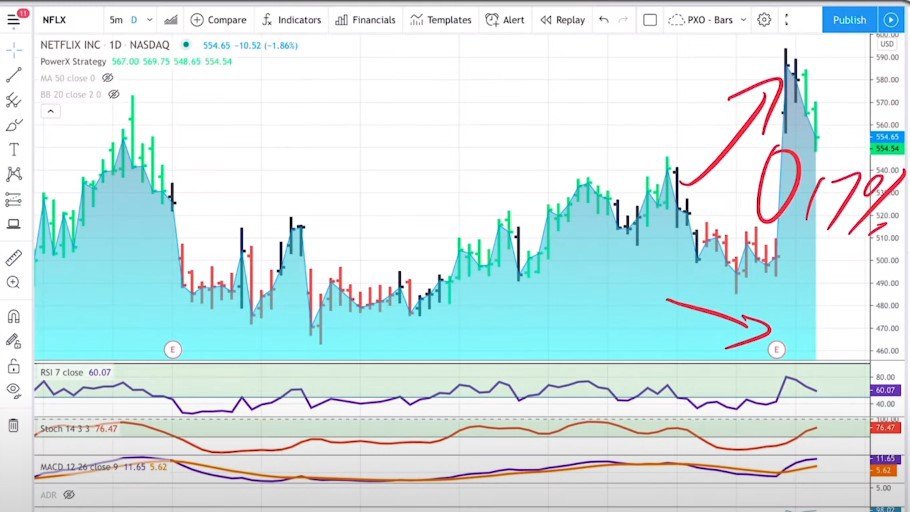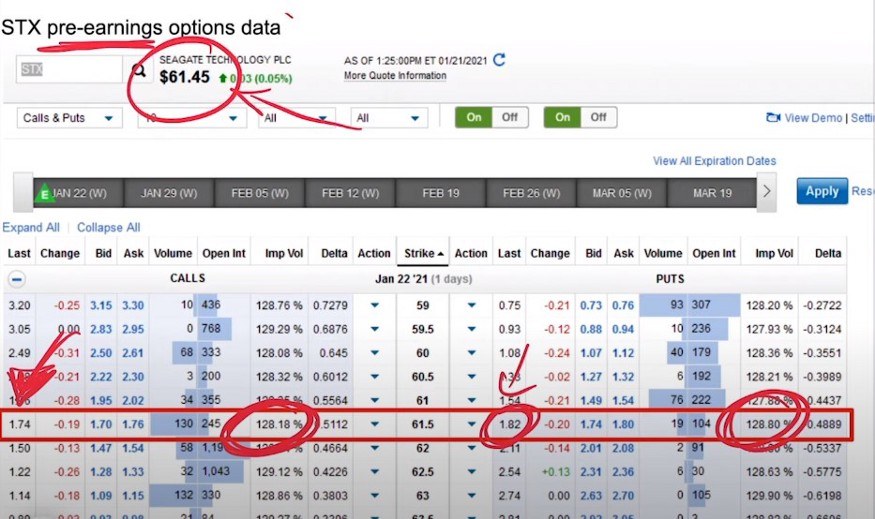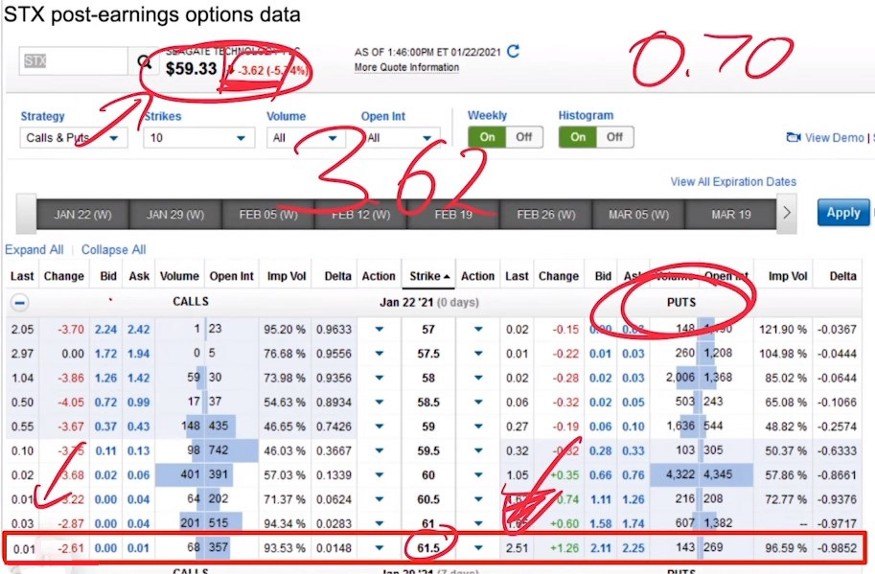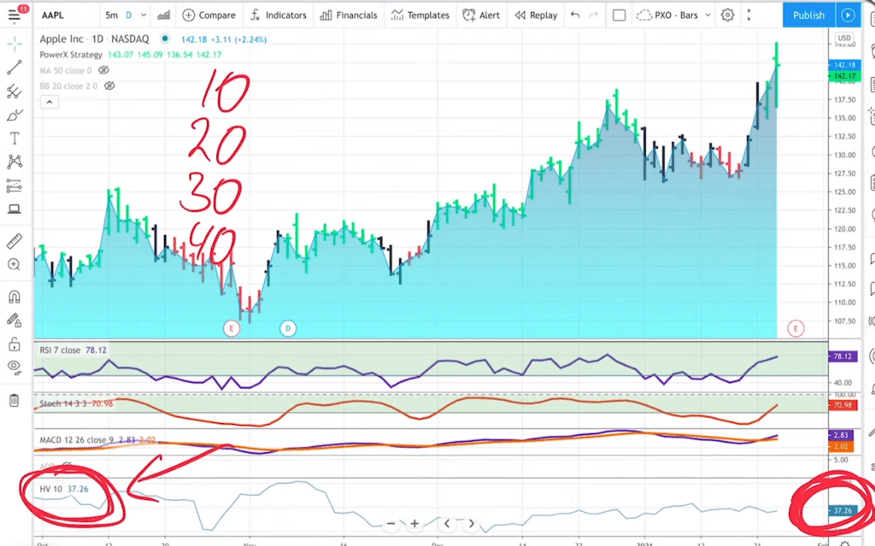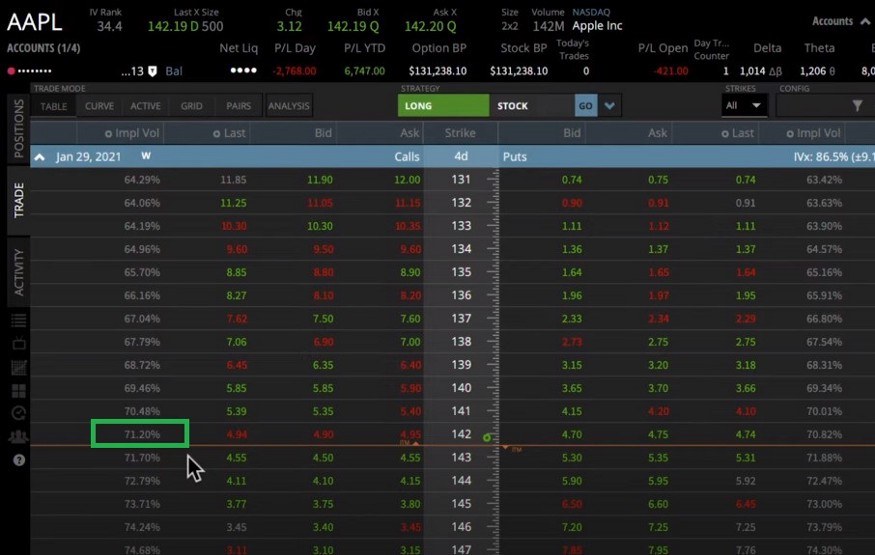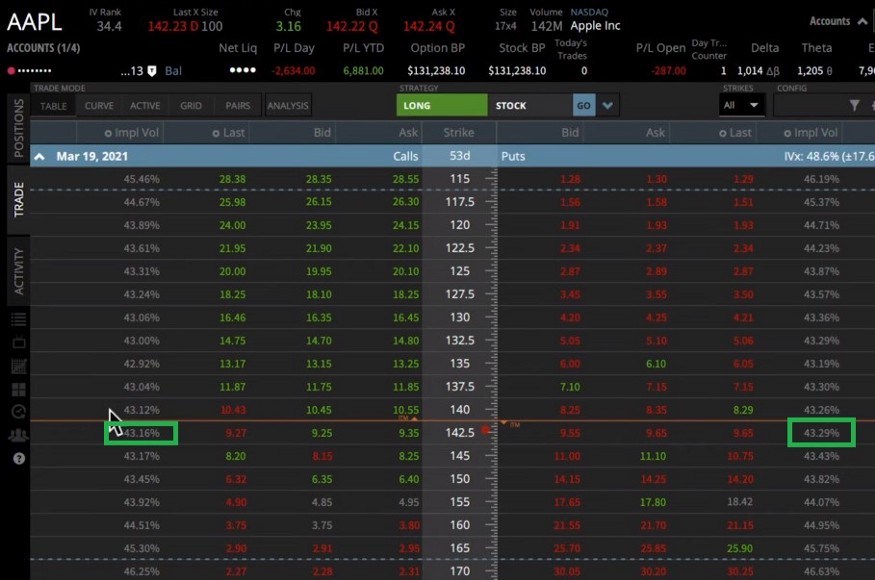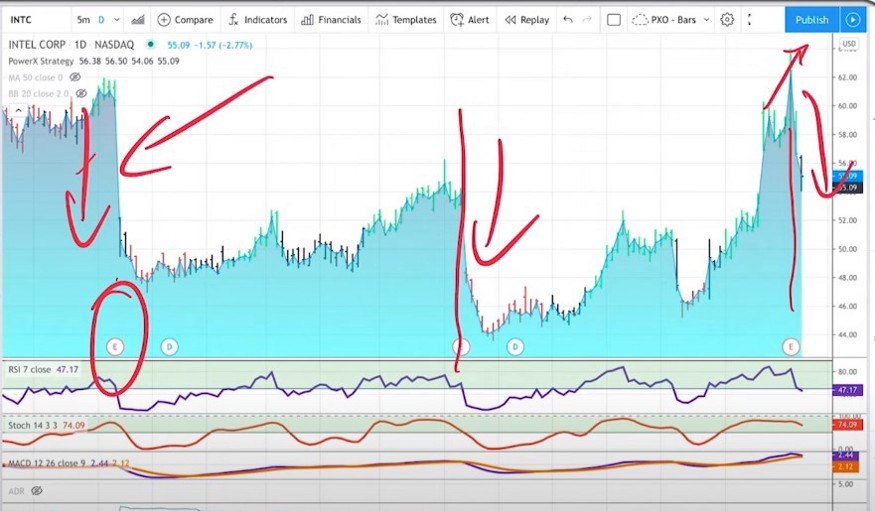As most of you are aware, it is earnings season. So today we’re going to talk about how earnings season can impact options trading, because, as you know, I trade options.
Now, just a brief intro. Earnings season happens quarterly, meaning four times a year, and this is when corporations reveal their financial results for the previous quarter.
Now, the results of a company’s earnings report can have a major impact on the stock price, and options will often price in the expectations for a big post-earnings move before the event. This is why it is likely that options premium are more expensive during this time.
Implied Volatility
One thing to know about this and how it can impact your trading is implied volatility. See, there several things that make up an options price, including the market’s expectation for future volatility, and that is called implied volatility.
So why is this important? Well, as the buyer of an option, higher implied volatility means that you are paying more for your contract. So if you buy an option before earnings and hold through earnings, you put yourself at risk for a so-called volatility crash.
Now, part of the reason implied volatility goes up so much ahead of earnings is because traders don’t know which way the stock is going to go or by how much. I mean, remember Netflix at the beginning of March? Who would have known that Netflix would soar 17%?
But you see, once a company reports earnings, there is no more uncertainty, and this is when implied volatility drops, and in some cases, so does the options price. So if you bought an expensive option, there’s a chance that you have to sell it to close at a lower price even if a stock moves in the direction you want it to.
And let me show you a very, very specific example of a volatility crash and why it is so important that you understand the concept of volatility and how it can impact your options trading. So I want to show you right here we see Seagate. Seagate reported earnings last week. And so here is the pre-earnings options data.
The day before Seagate, STX, was trading at $61.45, and an At-The-Money call with a 61.50 strike price was going for the last traded price of $1.74, and the implied volatility was 128%. On the other hand, the put was going for $1.82 and the implied volatility was also 128%.
Now, this was the day before earnings. Now let’s talk of what happened the day after earnings.
So again, here Seagate was trading at $61.45 before earnings, but then the next day, Seagate dropped to $59.33. So it fell dramatically and therefore, and the price of the 61.50 call is only a penny.
So it’s not surprising that the call is not worth anything, but here’s the key. Even though the stock fell quite substantially, the put only went from $1.82 to $2.51 so it went up because puts go up as the stock goes down.
So this means that the put only went up to $0.70, $0.69 to be exact. You see this is how the volatility crash affects the option price, because even though the put is worth more now, and is now in the money, but it also lost a lot of value due to the decline in implied volatility.
See, the previous day, it was 128%, this implied volatility, and the day after only 96%. So you have to factor this in when trading options into earnings.
How Is Implied Volatility Measured?
So let’s talk about this implied volatility thing and how is this measured, right? You know me, I’m all about practical stuff, so I don’t want to bore you with the math behind it and I don’t have to.
The good news is that there are plenty of places online that calculate the implied volatility for you, and I want to show you exactly how you can see if the implied volatility, is high, low, or average. Here is the easiest way to do it.
You compare the implied volatility to the stock’s historical volatility for exactly the same time frame. The implied volatility measures the market expectation for future price action. Now, the historical volatility measures the volatility for a stock that already occurred over a specific time frame. All you have to do to see if the implied volatility is high, low, or average compare it to the historical volatility.
We can use the implied volatility of Apple’s Q1 earnings season. Apple was trading at 142. For an at-the-money call, expiring in four days, the implied volatility was 71%, and for the put was 70%.
The historical volatility of Apple. And this is something that you’re charting software can show you, it makes sense to look at it in 10, 20, 30, 40 days increments. So if we were to look at the past 10 days, the historical volatility was 37%.
But the call was trading at 71%. So what does it tell us? It tells us that the premium on this call, and also on the put, was running more expensive than usual. So now we can see, how this is affected by earnings.
Now, let’s take a look at the implied volatility of an at-the-money Apple call from the same time that expired later out at, let’s say March 19th.
So for calls expiring March 19th, you see right now the implied volatility is much, much, much lower at 43% for the call, and 43% as well for the put.
The historical volatility over the past 60 days was 40.69%. Now compare this to the 43% and we see that it is pretty much in line here.
So this means that the premium that was on these calls and puts on options that had 53 days until expiration was pretty much average.
Why You Shouldn’t Sell Options Into Earnings
Options traders are always talking about implied volatility and historical volatility, and now you know what it is. Now I want to tell you why I don’t sell options into earnings. I mean, even though the stock moves in the direction that you want to, your option premium is getting sucked out of there because of the volatility crash.
You see, and this where, as an option seller, you might say, “don’t I want the premium to be as high as possible?” and yes, of course, you do.
But let me make you very clear why I don’t sell options into earnings. If you have been following me for a while, you know that I love trading the Wheel, and as part of this strategy, we are selling options. Well you see, earnings plays are hit-and-miss. Sure, everybody can get lucky and most people who start trading expect their account to explode from one or two big trades.
This is where we have some stocks that are jumping just dramatically. Looking at Intel, INTC over the last three earnings. Huge gap down right when we had earnings, then there was another earnings play, and Intel really crashed down hard again. Then also here during the last earnings season, initially, Intel went up but then started crashing down.
You see, some people like these earnings plays because they believe the hype that they can make a lot of money with very little work involved, but see, trading just doesn’t work this way because, in reality, the key to becoming successful in trading is consistency and growing your account systematically.
That’s what I mean when I talk about generating SRC profits, right? SRC is an acronym that stands for Systematic because I like to trade what I see and not what I think. This is why I use indicators and have a trading strategy that tells me when to trade, what to trade, when to enter and when to exit. The R stands for repeatable and by trading my plan, I’m able to find repeatable profit-making opportunities. The C in SRC profit stands for consistency.
You see, I’d rather make slightly less money more often than biting off all my nails waiting for a big winner. As you know, part of my systematic approach to trading is to use The Wheel Strategy and the PowerX strategy.
Now, especially with The Wheel strategy that, where I’m trading right now with you here, the idea is to get paid while you wait to buy the stock, and because I’m collecting premiums on the puts that I sell, I’m looking for stocks with higher volatility, right?
This means making more money, and as a rule of thumb, I look for stocks with an IV, implied volatility, of at least 40%. The Wheel strategy can relatively safely produce profits, but I don’t recommend you to trade into earnings, at least that’s not what I do.
So I will not target options with an expiration date that includes the company earnings report. I am trading options before we are running into earnings. So this is why I think it is very important that you know when trading options, whether it is buying or selling, that you don’t trade into earnings.
At least that’s what I do because earnings are a wildcard and there’s just too much uncertainty. Remember, I’m not looking for fireworks here, I’m looking to systematically grow my account through consistent and repeatable strategies.
Where To Check For Earnings
Now, I want to give you two more resources, if you want to see for yourself who is reporting and when. These are two websites that are pretty cool that I personally use. So the first one here is “stock earnings.” If you go to stockearnings.com or they even have stocksearning.com, they will show you see the notable earnings that are coming up this week.
Now, another one that many people like to use is earningswhispers.com. So that’s another great source for finding out when companies will report earnings because this way you can make sure that you’re not trading right into earnings.
It’s always good to know when they report earnings if you have any open positions, whether you’re buying stocks or selling stocks so that you’re not caught off guard.
So I hope that this helped you to see how earnings impact option prices and why I never sell options into earnings.
But the call was trading at 71%. So what does it tell us? It tells us that the premium on this call, and also on the put, was running more expensive than usual. So now we can see, how this is affected by earnings.
Now, let’s take a look at the implied volatility of an at-the-money Apple call from the same time that expired later out at, let’s say March 19th.
Trading Futures, options on futures and retail off-exchange foreign currency transactions involves substantial risk of loss and is not suitable for all investors. You should carefully consider whether trading is suitable for you in light of your circumstances, knowledge, and financial resources. You may lose all or more of your initial investment. The lower the day trade margin, the higher the leverage and riskier the trade. Leverage can work for you as well as against you; it magnifies gains as well as losses. Past performance is not necessarily indicative of future results.
Editors’ Picks

USD/JPY off lows, stays pressured near 142.50 ahead of BoJ policy decision
USD/JPY has bounced off lows but remains pressured near 142.50 in the Asian session on Friday. Markets turn risk-averse and flock to the safety in the Japanese Yen while the Fed-BoJ policy divergence and hot Japan's CPI data also support the Yen ahead of the BoJ policy verdict.

AUD/USD bears attack 0.6800 amid PBOC's status-quo, cautious mood
AUD/USD attacks 0.6800 in Friday's Asian trading, extending its gradual retreat after the PBOC unexpectedly left mortgage lending rates unchanged in September. A cautious market mood also adds to the weight on the Aussie. Fedspeak eyed.

Gold price treads water below record peak, awaits Fedspeak
Gold price hovers below the all-time peak touched earlier this week amid a bearish US Dollar and rising bets for more upcoming rate cuts by the Fed. Concerns over an economic downturn in China keep the safe-haven Gold price afloat. Fedspeak remains on tap.

Bank of Japan set to keep rates on hold after July’s hike shocked markets
The Bank of Japan is expected to keep its short-term interest rate target between 0.15% and 0.25% on Friday, following the conclusion of its two-day monetary policy review. The decision is set to be announced during the early Asian session.

XRP eyes gains as Ripple gears up for stablecoin launch, Grayscale XRP Trust notes rising NAV
Ripple (XRP) gained 2.3% since the start of the week. The altcoin’s gains are likely powered by key market movers that include Ripple USD (RUSD) stablecoin, Grayscale XRP Trust performance and the demand for the altcoin among institutional investors.
RECOMMENDED LESSONS
Making money in forex is easy if you know how the bankers trade!
Discover how to make money in forex is easy if you know how the bankers trade!
5 Forex News Events You Need To Know
In the fast moving world of currency markets, it is extremely important for new traders to know the list of important forex news...
Top 10 Chart Patterns Every Trader Should Know
Chart patterns are one of the most effective trading tools for a trader. They are pure price-action, and form on the basis of underlying buying and...
7 Ways to Avoid Forex Scams
The forex industry is recently seeing more and more scams. Here are 7 ways to avoid losing your money in such scams: Forex scams are becoming frequent. Michael Greenberg reports on luxurious expenses, including a submarine bought from the money taken from forex traders. Here’s another report of a forex fraud. So, how can we avoid falling in such forex scams?
What Are the 10 Fatal Mistakes Traders Make
Trading is exciting. Trading is hard. Trading is extremely hard. Some say that it takes more than 10,000 hours to master. Others believe that trading is the way to quick riches. They might be both wrong. What is important to know that no matter how experienced you are, mistakes will be part of the trading process.

Moneta Markets review 2024: All you need to know
VERIFIED In this review, the FXStreet team provides an independent and thorough analysis based on direct testing and real experiences with Moneta Markets – an excellent broker for novice to intermediate forex traders who want to broaden their knowledge base.
